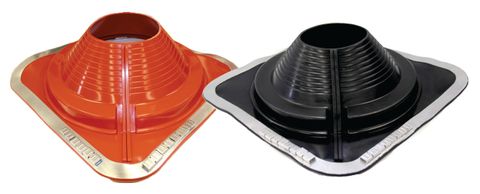570100.1200 Black Combo Pipe Flashings for Standard & Retrofit use










Combo is the latest innovation in metal roof flashings, where one product suits both new and retrofit applications. Retrofit flashings (also called a split flashing or split boot) are used in applications where you cannot slide the flashing over / down a penetration. The retrofit flashing is split to allow you to wrap around the penetration and form a permanent seal with the help of clips. The clips are included with each Combo flashing for retrofit applications.
• Black and Grey Combo's are manufactured from a specially formulated EPDM rubber polymer for durability, UV characteristics and the ability to withstand constant temperatures between – 50°C to 115°C.
• Red Silicone Combo's provide durability, UV characteristics and the ability to withstand constant temperatures between – 50°C to 200°C.
• Red Silicone Combo's provide durability, UV characteristics and the ability to withstand constant temperatures between – 50°C to 200°C.
For applications where the Flashing can be slid down over the top of the pipe.
1.Trim rubber boot to suit pipe size, ensure surface is clean and dry before application.
2. Slide down pipe using water as a lubricant, if needed
3. Press the flashing base firmly to conform to the shape of the roof profile, smooth out any creases.
4. Using a pencil or marker, mark a line on the roof around the perimeter of the base of the flashing. Ensure the pencil or marker is compatible with the roof profile material.
5. Lift the flashing up the pipe far enough to allow for application of the sealant.
6. Apply the sealant to the roof profile just inside the marked perimeter line.
7 Slide the flashing to down the pipe to its previous conformed position.
8 Apply pressure to create a seal then fasten using self-drilling screws with EPDM Seals fitted.
Ensure the first screws used are at either side of a crest of the profile starting at the direction from which the water will flow and work your way around from there. Screws should be a maximum of 30~35mm apart.
For applications where the Flashing cannot be slid down over the top of the pipe. (Retro fitting)
1. Trim rubber boot to suit pipe size, then cut the seam of the flashing. Ensure surface is clean and dry before application.
2. With seam in downstream position wrap boot around pipe and engage 1st double
clip at top of seam using multigrips, then, engage remaining clips working down from
top of tuber boot to base.
3. Press the flashing base firmly to conform to the shape of the roof profile, smooth out any creases.
4. Using a pencil or marker, mark a line on the roof around the perimeter of the base of the flashing. Ensure the pencil or marker is compatible with the roof profile material.
5. Lift the flashing up the pipe far enough to allow for application of the sealant.
6. Apply the sealant to the roof profile just inside the marked perimeter line.
7 Slide the flashing to down the pipe to its previous conformed position..
4. Apply pressure to create a seal then fasten using self-drilling screws with EPDM Seals fitted.
Ensure the first screws used are at either side of a crest of the profile starting at the direction from which the water will flow and work your way around from there. Screws should be a maximum of 30~35mm apart.
1.Trim rubber boot to suit pipe size, ensure surface is clean and dry before application.
2. Slide down pipe using water as a lubricant, if needed
3. Press the flashing base firmly to conform to the shape of the roof profile, smooth out any creases.
4. Using a pencil or marker, mark a line on the roof around the perimeter of the base of the flashing. Ensure the pencil or marker is compatible with the roof profile material.
5. Lift the flashing up the pipe far enough to allow for application of the sealant.
6. Apply the sealant to the roof profile just inside the marked perimeter line.
7 Slide the flashing to down the pipe to its previous conformed position.
8 Apply pressure to create a seal then fasten using self-drilling screws with EPDM Seals fitted.
Ensure the first screws used are at either side of a crest of the profile starting at the direction from which the water will flow and work your way around from there. Screws should be a maximum of 30~35mm apart.
For applications where the Flashing cannot be slid down over the top of the pipe. (Retro fitting)
1. Trim rubber boot to suit pipe size, then cut the seam of the flashing. Ensure surface is clean and dry before application.
2. With seam in downstream position wrap boot around pipe and engage 1st double
clip at top of seam using multigrips, then, engage remaining clips working down from
top of tuber boot to base.
3. Press the flashing base firmly to conform to the shape of the roof profile, smooth out any creases.
4. Using a pencil or marker, mark a line on the roof around the perimeter of the base of the flashing. Ensure the pencil or marker is compatible with the roof profile material.
5. Lift the flashing up the pipe far enough to allow for application of the sealant.
6. Apply the sealant to the roof profile just inside the marked perimeter line.
7 Slide the flashing to down the pipe to its previous conformed position..
4. Apply pressure to create a seal then fasten using self-drilling screws with EPDM Seals fitted.
Ensure the first screws used are at either side of a crest of the profile starting at the direction from which the water will flow and work your way around from there. Screws should be a maximum of 30~35mm apart.
• The combo suits roof pitches between 0 to 40°.
| Size | Pack Type | Colour | 480 Y Material | 490 Y Description/Features | 610 Y Base Size | Code |
|---|---|---|---|---|---|---|
| No. 01 |
|
|||||
| No. 02 |
|
|||||
| No. 03 |
|
|||||
| No. 04 |
|
|||||
| No. 05 |
|
|||||
| No. 06 |
|
|||||
| No. 07 |
|
|||||
| No. 08 |
|
|||||
| No. 10 |
|
